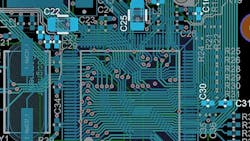Download this article in .PDF format
This file type includes high resolution graphics and schematics when applicable.
It’s the old adage of the tortoise and the hare. In the race to complete a working development project that includes a printed-circuit board (PCB), the temptation often is to concentrate on the design exclusively until finished. Like the hare, it’s blast ahead full-speed into the creation of a design file that works like you want it to in the circuit simulator. The tortoise, on the other hand, handles the project by doing some additional research even before starting the physical layout.
The approach to solving the problem of designing a PCB-based product can vary greatly. But which method is fastest? Which is most effective? Which consumes the least project resources? All are good questions that have a strong influence on the success of your project, but they don’t necessarily provide a clear path to success from the beginning. One can hear the head designer planning out the project approach: “Do we do what we think we need to do with the design, then hope somebody can build it without busting our budget, or do we pick a fabricator first, even if it means potentially limiting our freedom of design?”
For PCB designers, there are two choices. First, you can design in a vacuum, and then hunt for a manufacturing chain that can build the design. Second, learn about your manufacturing chain and optimize your design to the fabricator’s strengths while maintaining desired functionality.
Here are five strategies that help you plan ahead for success, without adding weeks or unnecessary cost to your design cycle.
1. Research and select suppliers earlier in the design cycle.
The design team knows that at prototype design completion, the next logical step in the design process is to get back a working example of the prototype design for testing. Though this represents one logical step to the design team, this process consists of multiple steps—components must be procured; the PCB has to be fabricated; and the parts need to be correctly attached to the PCB. How this manufacturing flow ultimately occurs is up to the design team to select and manage.
“Understanding the manufacturing flow, including component availability and service-provider capability, ahead of time can reduce the chances of rework and redesign,” says Duane Benson, marketing manager at Screaming Circuits, a Canby, Ore.-based assembler, “Knowing what you’re up against reduces risk.”
In our discussions with PCB design teams, we find a correlation. Professional teams turning lots of simpler designs with wide tolerances in the process window tend toward using a one-stop supplier for the overall convenience. Professional teams whose designs require careful tuning and attention to manufacturing details tend toward managing each relationship throughout the build process, handpicking each supplier for their strengths, abilities, and turn times. For some teams with limited budgets, price can be much more important than turn times. For other teams under tight deadlines, fast becomes a priority. Of course, in all cases, the PCB must be manufactured to the design.
Requirements can change from project to project. But that doesn’t necessarily mean you need a different supplier for each project. Talk with suppliers’ customer service technical teams or sales teams, and determine just how well they can respond with quality/turn times/pricing/delivery across the whole range of your anticipated project styles. Chances are good that the conversation time will be well spent by finding the right supplier for your team’s typical project constraints.
Three key items that will come up in the discussion are PCB fabrication, parts procurement, and assembly:
• Fabricating the PCB that serves as the connection medium for all the components and connectors that make up your circuit design. While this may seem like just another “part” on the design team’s bill of materials (BOM), this is a critical, custom-manufactured part. It requires adherence to your design parameters and can represent the most variable cost in the BOM.
These are the chips, connectors, and other parts that operate to make your circuit perform as intended. The components come from a parts distributor or retailer. The more one-stop services your manufacturing chain supplies, the more likely they will offer the parts procurement services for you… at a price, of course.
• Many design teams prefer to take a very hands-on approach with parts for their prototypes. This is neither the time nor place for parts substitutions to save cost; that step comes later. Direct involvement by the design team requires careful attention to detail and time, but the team also eliminates a number of potential bugs in the prototype with this approach, saving time and cost in the long run.
• The process of attaching components to the printed-circuit board. Depending on the design team, you may or may not have the expertise or equipment to perform this function yourself. As parts and designs get smaller and denser, the need for an outside service becomes more indispensable.
In the process of getting to know your manufacturing chain, you should assess your contacts for their ability to consult on your design particulars. The more advice a manufacturing supplier can give you, or help make your design optimization more efficient, the more value they provide to the design process, and that’s free consulting help to you!
2. Optimize for cost and performance before layout.
Not long ago, our colleague at Screaming Circuits, Duane Benson, blogged about optimizing designs to remove unnecessary components. In a general sense, the fewer components that are needed to implement your circuit, the more reliable your end product. Screaming Circuits’ Benson says, “Reuse of code and of schematic modules can be a great help in keeping schedules under control. However, if you do so, it’s important to make sure every part of what you're reusing is necessary.”
Costs don’t simply refer to the number of components used in a design. They also tie into PCB real estate and design complexity, flying probe test times, and opportunities for design-related manufacturing issues.
3. Develop your layout to the fabricator’s “sweet spot.”
Nancy Viter, Sunstone Circuits’ manufacturing director, has wise words about fabrication: “While almost anything that you can lay out can be built, it is much more cost-effective to design to the heart of the capability range of your manufacturer, when possible.”
Regardless of whom you choose, your fabricator has a sweet spot—that place where designs are well inside the middle of the manufacturing process window. From this spot, minor variations in manufacturing still keep your design well inside manufacturing capabilities, and thus increase your yields and reliability.
4. Verify your layout’s manufacturability with a supplier DFM tool.
A reputable PCB fabricator will run your design through a design-for-manufacturability (DFM) tool to check for errors above and beyond any visual inspection of the design details. A top-tier fabricator will make that report available to you when submitting your design for quotation. Using the contents of that report, which verifies if your design will fit inside the manufacturing process, is a valuable step to getting a properly fabricated board, and is the first measure toward developing a board optimized for production.
5. Manage prototyping costs and hidden costs.
Prototyping creates more robust designs from the first revision with proper preparation. While it may seem like a lot of useless preparation work, consider the hidden costs of a five-person design team, spending five person-days to complete the preparations mentioned here. Such a preparatory process might save you at least one prototype spin of—you guessed it—five calendar days. Except five calendar days for a design team of five is a total of 25 person-days.
Conclusion
When the PCB design is simple, or far away from the current technological edge, these strategies have less impact on your design cycles. One school of thought is that, as you move to surface mounts to QFN/QFP packages, or as you move to tight tolerances in circuit timing, then these strategies become more and more important. Of course, the other school of thought is that, as you start out, even though the designs may be simpler, it’s the designer’s skimpy knowledgebase that needs more support.
“We consider ourselves partners with our customers and as an important resource for them,” says Sunstone’s Al Secchi, “We are only successful when we can help our customers be successful in avoiding design issues that can affect either the manufacturability or functionality of their PCB. We know how important it is for them to receive functioning boards on time, and we pride ourselves with an on-time rate that consistently exceeds 99.5%.”
Regardless of whether you choose to design like a “hare” or a “tortoise,” a close working relationship with the PCB fabricator is critical. Make your PCB manufacturer a key and valuable part of your “design council.”
Download this article in .PDF format
This file type includes high resolution graphics and schematics when applicable.
About the Author

Nolan Johnson
CAD/EDA Manager
As CAD/EDA Manager, Johnson brings to Sunstone a career that has been focused entirely on electronics manufacturing. Trained as a software engineer, Johnson wrote applications software for Mentor Graphics before transitioning into technical marketing roles. He managed Mentor’s OEM verification development projects, including Dracula™ and CheckMate™. Johnson then concentrated on operating technical training centers for semiconductor manufacturing and telecom analysis equipment at both Electro Scientific Industries and Tektronix. With over four years at Sunstone Circuits, Nolan Johnson has assisted in the many successful initiatives of their core product line, including an integral role in the development of their PCB123 design software. His enhancement of the software’s schematic functionality and Live BOM (Bill of Materials), has helped make PCB123 the most advanced industrial-grade CAD tool in the marketplace.
Johnson holds a Bachelor’s Degree in Computer Science from Oregon State University.
